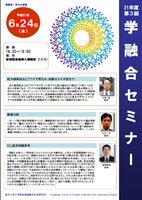AY2009 3rd Gakuyugo Seminar
- Date&Time:
- Jun 24, 2009 16:30 - 18:00
- Venue:
- Large Lecture Room (2C0), New Frontier Science Bldg.

Magnetic recombination and plasma confinement - from nuclear fusion to space
Professor Yasushi Ono
Magnetic field line recombination is a phenomenon in which antiparallel magnetic field lines approach each other in a plasma and reconnect in an X-shape. It has been studied as a fundamental phenomenon that plays a key role in the magnetic field structure change and anomalous heating of plasmas, and the new laboratory experimental method of torus plasma coalescence has led to rapid progress in clarifying the phenomenon. The TS-3/4 plasma coalescence experiment at the University of Tokyo, which was a pioneer in this movement, will be introduced as an experimental study connecting space, laboratory and fusion.

Talking about sugar chains
Professor Kazuo Yamamoto
Glycosylation is one of the post-translational modifications of proteins. Unlike the amino acid sequence, which is uniquely determined based on genetic information composed of nucleic acids, the shape of the glycan changes in response to the environment in the body. The differences in the structure of glycans provide a variety of information, and they perform various functions such as dynamically changing the movement of proteins and cells, and controlling their activation. The role of glycans and research targeting them will be introduced.

Rethinking CO2 Ocean Sequestration
Professor Masahiko Ozaki
Among the CO2 capture and storage (CCS) methods that separate CO2 from combustion exhaust gas and sequester it from the atmosphere for a long period of time as a countermeasure against global warming, "geological storage" has recently been attracting a great deal of interest. However, Japan's national program initially focused on ocean sequestration, and research on methods to assess the impact of CO2 on the marine environment and the development of technologies to minimize the impact were conducted. In the end, the need for CCS became imminent before the London Convention, which prohibits ocean dumping, could be overcome, and it was reaffirmed that it is very difficult to deal with the "marine environment" when using the ocean on a large scale. There is a possibility that we will eventually run into this problem in the expected "development of hydrothermal deposits," "development of methane hydrates," and "development of marine biomass. If the process of realizing the concept on a commercial basis requires a way of doing things unique to the ocean, it is likely that the same mistake will be made if it is not tackled through academic integration rather than partial academic cooperation. I would like to introduce the efforts of the national project on CO2 ocean sequestration as a case study to encourage people to think about the methodology to make the ocean usable on a large scale.
*The contents of this page were developed based on a machine translation.

